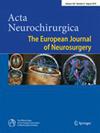外、内窥镜两步法治疗前方脑膜瘤:我是怎么做的
IF 1.9
3区 医学
Q3 CLINICAL NEUROLOGY
引用次数: 0
摘要
前枕骨大孔(AFM)脑膜瘤是难以治疗的,因为他们位于解剖复杂的区域。AFM脑膜瘤最常见的入路之一是远侧入路。我们通过枕下开颅术描述我们的外腔和内窥镜两步入路(EETA)。外窥镜用于切除肿瘤的外侧部分,而内窥镜用于切除外窥镜盲点的残余肿瘤,包括脑干的腹侧。EETA是治疗AFM脑膜瘤的可行选择,因为它提供了足够的手术视野,并且是微创的。本文章由计算机程序翻译,如有差异,请以英文原文为准。
Exo- and endoscopic two-step approach for anterior foramen magnum meningiomas: How I do it
Anterior foramen magnum (AFM) meningiomas are difficult to treat because they are situated in anatomically complex regions. One of the most common approaches for AFM meningiomas is the far lateral approach. We describe our exo- and endoscopic two-step approach (EETA) through suboccipital craniotomy. An exoscope is used to remove the tumour’s lateral part, whereas an endoscope is used to remove the residual tumour in the exoscope’s blind spots, including the brainstem’s ventral side. EETA is a viable option for treating AFM meningiomas because it provides an adequate surgical field of view and is minimally invasive.
求助全文
通过发布文献求助,成功后即可免费获取论文全文。
去求助
来源期刊

Acta Neurochirurgica
医学-临床神经学
CiteScore
4.40
自引率
4.20%
发文量
342
审稿时长
1 months
期刊介绍:
The journal "Acta Neurochirurgica" publishes only original papers useful both to research and clinical work. Papers should deal with clinical neurosurgery - diagnosis and diagnostic techniques, operative surgery and results, postoperative treatment - or with research work in neuroscience if the underlying questions or the results are of neurosurgical interest. Reports on congresses are given in brief accounts. As official organ of the European Association of Neurosurgical Societies the journal publishes all announcements of the E.A.N.S. and reports on the activities of its member societies. Only contributions written in English will be accepted.
 求助内容:
求助内容: 应助结果提醒方式:
应助结果提醒方式:


